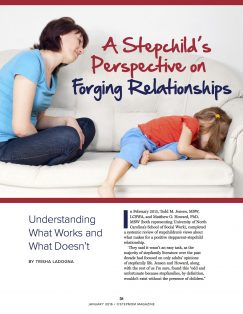
A Stepchild’s Perspective on Forging Relationships – Understanding What Works and What Doesn’t by Trisha Ladogna
In February 2015, Todd M. Jensen, MSW, LCSWA, and Matthew O. Howard, PhD, MSW (both representing University of North Carolina’s School of Social Work), completed a systemic review of stepchildren’s views about what makes for a positive stepparent-stepchild relationship.
They said it wasn’t an easy task, as the majority of stepfamily literature over the past decade had focused on only adults’ opinions of stepfamily life. Jensen and Howard, along with the rest of us I’m sure, found this “odd and unfortunate because stepfamilies, by definition, wouldn’t exist without the presence of children.”
It’s true: Stepfamily relationships aren’t established by individual actions. They rely on the collective interactions of everyone involved and stepchildren have just as big a role to play as anyone else. There is a tendency, however, to place responsibility for the stepparent-stepchild relationship squarely on stepparents’ shoulders.
Even in related literature, there is an implied belief that a stepparent owns full responsibility for the quality of the relationship they have with their stepchild—good or bad. But children are not just passive observers. Whether they reside in a stepfamily or not, children equally contribute (positively or negatively) to the relationships they have with the adults in their lives.
The significance for those of us who reside in stepfamilies is that positive stepparent-stepchild relationships actually predict stepfamily stability. To avoid becoming a second (or subsequent) marriage divorce-rate statistic, a positive and healthy relationship between a stepchild and their stepparent forms part of the solution.
In fact, Claire Cartwright, PhD (at the University of Auckland), found that stepparent-stepchild relationships not only impact how stepparents feel about themselves, but they also affect a stepchild’s self-esteem and the closeness of the stepcouple relationship. So, the relationship you and your stepchild have with each other really does matter.
Here, Jensen and Howard’s work provides us a sneak peek into what children who live in stepfamilies believe makes or breaks a relationship between a stepchild and their stepparent. …To read the rest of this article and understand your stepchild’s perspective, log in to your account and download the January 2016 issue. Don’t have an account? Click here to subscribe.
